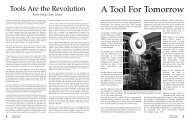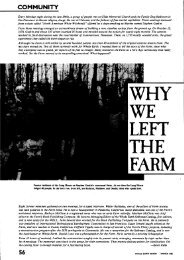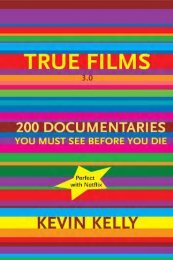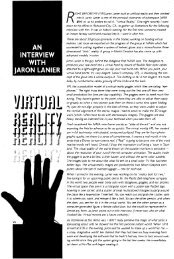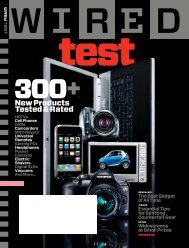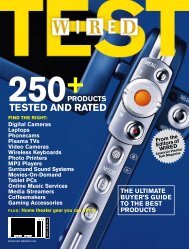PDF version - Kevin Kelly
PDF version - Kevin Kelly
PDF version - Kevin Kelly
Create successful ePaper yourself
Turn your PDF publications into a flip-book with our unique Google optimized e-Paper software.
aging director of TCN, considers his<br />
task to be to ease nonprofit organizations<br />
into the network nation-or to restrain<br />
them from making the leap if it seems<br />
unnecessary. "Technology won't do<br />
wonder cures," says Loeb. "We simply<br />
offer intelligent counsel when it's hard<br />
to find."<br />
Third World appropriate technology<br />
has also been boosted by a network<br />
assembled to assist in areas where normal<br />
channels of communication are absent,<br />
as in the jungles of Papua New<br />
Guinea. This network, EcoNet, has<br />
already scored one unusual success.<br />
When villagers in Tonga and Costa<br />
Rica experienced a problem with crumbling<br />
cooking stoves (built from homemade<br />
cement), they hooked up with<br />
EcoNet via pan-Pacific satellite. Experts<br />
at California universities unearthed the<br />
problem: the villagers were neglecting<br />
to wash the salt out of sand they were<br />
ing in the cement. "Eventually," says<br />
r. Bryan Farrell, a university re-<br />
age by humdrum, post office mail: two<br />
disks and a manual. I pop one disk into<br />
the computer; after three or four minutes<br />
of introductory messages, my<br />
teacher's portrait materializes in little<br />
dots on the screen. A caption describes<br />
her as Miriam Ylvisaker, a consultant<br />
for the Bay Area Writing Project at the<br />
University of California, Berkeley. It's<br />
a good trick: for the rest of the course, I<br />
feel that she, not the silly computer, is<br />
talking to me.<br />
Somewhat skeptical of the matchbookcover<br />
image of correspondence courses,<br />
I was surprised by the tutorial's freewheeling<br />
approach. The first class was<br />
aica talking to villagers<br />
t creating clean water<br />
't do that yet, but we<br />
1C NETWORKS ma<br />
Telelearning, a futuristic<br />
educational tool, evokes<br />
images of kids at home<br />
wired into Yale.<br />
how we learn.<br />
Telelearning, a futuristic educational<br />
tool, evokes images of kids at home<br />
schools wired into Yale. A place in the<br />
country, an orchard out back, wood<br />
stacked up, a terminal on the kitchen<br />
table, and Johnny doing algebra problems<br />
in his baseball uniform. The fam-<br />
a remodeled study in an old house in a<br />
small town in Georgia, beehives in the<br />
rd. My computer dials San Franand<br />
I log on to Telelearning, a<br />
any billed as the Electronic Unirsity,<br />
and register for a course called 1<br />
called Brainstorming. "To get some<br />
writing done, you need to get some<br />
ideas," says Ms. Ylvisaker's program,<br />
"and while you get ideas, you can't be<br />
thinking if they're any good-just write<br />
them down without stopping. Go back<br />
later to edit them, pick the best ones,<br />
and repeat the cycle."<br />
A series of writing exercises follow;<br />
my work is saved on a computer storage<br />
disk. When the lesson is over, the text is<br />
automatically transmitted to San Francisco<br />
via phone lines and read by Ms.<br />
Ylvisaker-"within forty-eight hours,"<br />
promises Telelearning. My second lesson<br />
begins with the comments my teacher<br />
left on the network. Ordinarily, teacher<br />
and student aren't on-line simultane-<br />
ously, nor is there a "class" going on,<br />
as I first supposed. Eventuallv. Tele-



